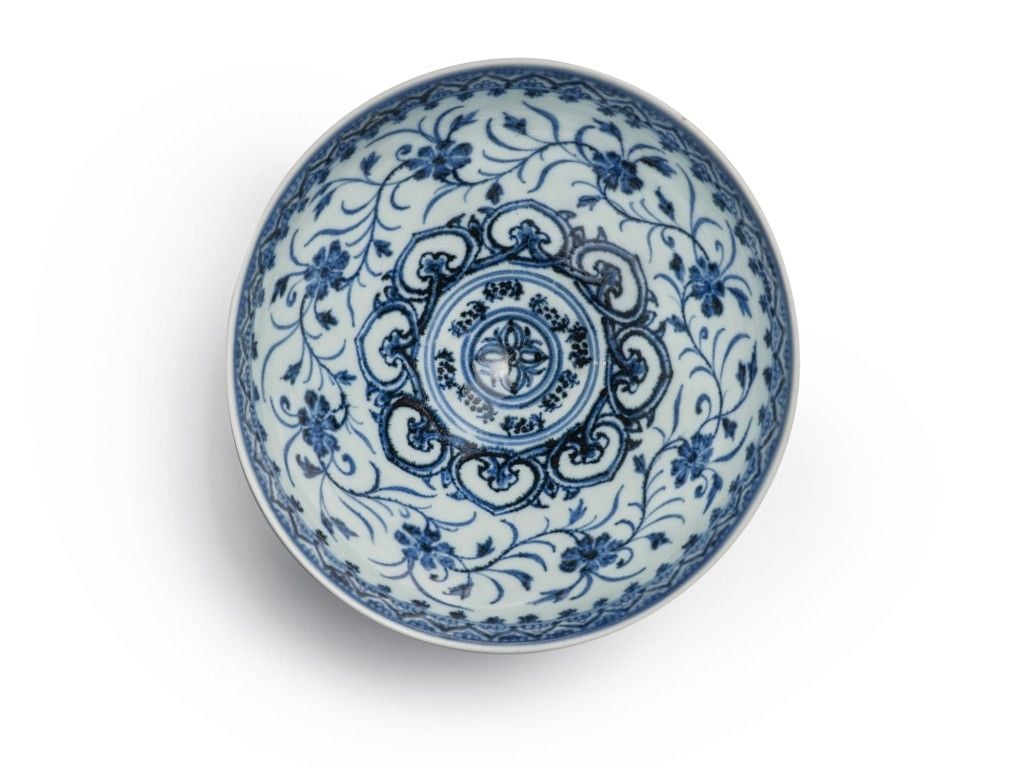Porcelain Bowl Bought at Yard Sale for $35 Could Sell at Auction for $500,000
The blue-and-white vessel is a rare Ming dynasty dish dated to the early 15th century
:focal(904x742:905x743)/https://tf-cmsv2-smithsonianmag-media.s3.amazonaws.com/filer/14/17/14170578-8b1b-47e0-bca8-a1988929f7d8/157n10644-brycj-10.jpg)
Last year, a man perusing a yard sale near New Haven, Connecticut, purchased a blue-and-white Chinese bowl for $35. Now, reports Oscar Holland for CNN, the savvy shopper—whose bargain buy turned out to be a rare Ming dynasty–era ceramic—is putting his find up for auction at Sotheby’s, where experts expect it to sell for between $300,000 and $500,000.
The 6.25-inch-wide bowl will go under the hammer in Sotheby’s March 17 “Highlights From Important Chinese Art” sale. As the auction listing states, the ornately decorated dish, which features depictions of lotuses, peonies, chrysanthemums and pomegranate blossoms, dates back to the reign of the Yongle Emperor (1403–1424). Its upper estimate of $500,000 is nearly 14,300 times the receptacle’s original cost, notes Chinese newspaper World Journal.
Angela McAteer, head of Sotheby’s Chinese art department, tells CNN that the unnamed owner “didn’t haggle over the $35 asking price.”
Soon after purchasing the piece, he sent a picture of it to auctioneers, who verified its status as an “item of historical significance,” per Metro’s Jack Longstaff.
/https://tf-cmsv2-smithsonianmag-media.s3.amazonaws.com/filer/b1/7d/b17d64d8-8c4f-4bcd-be11-4726d17acd1f/157n10644-brycj-05.jpg)
Only six comparable dishes are known to exist today, according to Sotheby’s. These specimens are housed in such prominent cultural institutions as Taipei’s Palace Museum, the National Museum of Iran, the British Museum, and the Victoria and Albert Museum. (Exactly how such a rare artifact ended up at a Connecticut yard sale remains a mystery.)
Known as a “lotus bowl” due to its resemblance to the eponymous bud (lianzi)—or, in a drastically different interpretation, a chicken heart (jixin)—the vessel has curved sides and a tapered base. Intertwined flower petals adorn its sides, and a ring of lotus scrolls borders its rim.
“In every respect,” says the listing, “this delicate bowl is a quintessential Yongle product, made for the court, showing the striking combination of superb material and painting.”
Speaking with CNN, McAteer adds that the bowl boasts an “incredibly smooth porcelain body” and a “really unctuous silky glaze [that] was never replicated in future reigns or dynasties.”
Ming ceramics are renowned for their cobalt blue–and–titanium white porcelain, which was often produced in places like Jingdezhen in southern China, noted Mark Cartwright for World History Encyclopedia in 2019. Spanning 1368 to 1644, the Ming period saw a significant uptick in ceramic production; during his reign, the Yongle Emperor commissioned a broad range of porcelain objects for his court, wielding greater government control over the kilns in Jingdezhen.

Per World History Encyclopedia, an economic boom in the 15th century increased demand for handmade crafts, with members of the aristocracy seeking creative ways to display their newfound wealth. As the Ming dynasty progressed, designs became increasingly elaborate. By the 18th century, the industry had grown to such an extent that a single porcelain object could carry the traces of some 70 different specialists’ work.
Today, Ming pottery is still highly valued. In 2014, for instance, a small 15th-century bowl representative of the dynasty’s style fetched a staggering $36.3 million at auction (around $40 million when adjusted for inflation).
“The Yongle Emperor really promoted the artistic importance of porcelain,” McAteer tells CNN. “He elevated it from being a utilitarian bowl, for example, into a true work of art.”
The lotus bowl is just one item on offer during Sotheby’s “Asia Week” (March 11–24), which is slated to showcase objects and art from across the continent. Other highlights include a bronze food vessel dated to 1072 B.C., a leaf-adorned Tang dynasty receptacle and a gilt-bronze temple bell from the Qing dynasty.
/https://tf-cmsv2-smithsonianmag-media.s3.amazonaws.com/accounts/headshot/Isis_Davis-Marks_thumbnail.png)
/https://tf-cmsv2-smithsonianmag-media.s3.amazonaws.com/accounts/headshot/Isis_Davis-Marks_thumbnail.png)